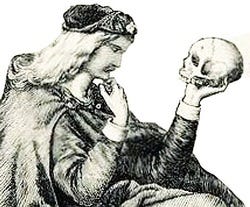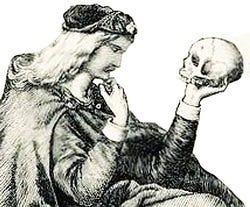Hamlet’s Existential Question
Shakespeare’s Profound Meditation on Death, Madness, and the Moral Dilemmas of Revenge
“To be, or not to be—that is the question…” The moment these words are uttered by Hamlet, Shakespeare plunges us into the depths of human existence. This is more than a mere reflection on life or a cry of despair; it is the voice of a man wrestling with the profoundest questions of life, death, and meaning. Written at the turn of the 17th century, Hamlet remains one of Shakespeare’s most enduring works because it grapples with questions that are timeless and universal. How do we navigate a world where death is inevitable, madness may lurk within us all, and the thirst for revenge can consume even the noblest of hearts?
The Soliloquies: Windows into Hamlet’s Troubled Mind
Shakespeare’s genius lies in his ability to use soliloquies as windows into the human soul. For Hamlet, these soliloquies are not merely moments of introspection but rather philosophical meditations that draw the audience into his existential crisis. From the very beginning, Hamlet’s grief over his father’s sudden death and his mother’s hasty remarriage spirals into an obsession with death itself.
In Act 1, Scene 2, Hamlet laments, “O, that this too too solid flesh would melt, thaw, and resolve itself into a dew!” Here, Shakespeare introduces us to Hamlet’s weariness, a desire for his own annihilation in the face of what he sees as a deeply flawed world. Yet, what truly haunts Hamlet is not just his personal despair, but a larger existential fear—what lies beyond death?
Death: The Fearful Unknown
If there is one theme that overshadows all others in Hamlet, it is death. The famous “To be, or not to be” soliloquy in Act 3, Scene 1 delves into the very nature of existence. Is it better to endure the “slings and arrows of outrageous fortune” or to take arms against a sea of troubles by ending one’s life? Hamlet’s hesitation is not born of cowardice but of profound philosophical contemplation.
Shakespeare presents death as a paradox: a release from life’s suffering yet an entrance into an unknown realm that may hold even greater torments. “The dread of something after death, the undiscovered country, from whose bourn no traveler returns, puzzles the will.” Hamlet’s fear is not of death itself, but of what comes after—a realm that remains shrouded in uncertainty and dread. Here, we see Shakespeare’s reflection on the human condition: the inevitability of death and the fear that it may not bring the peace we long for.
The graveyard scene in Act 5, Scene 1 serves as a powerful symbol of death’s universality. Hamlet’s encounter with Yorick’s skull forces him to confront the reality that all men—be they kings or jesters—end up as dust. Yet, it is not a scene devoid of hope but rather a meditation on the transience of life and the need for spiritual reflection before it is too late.
Madness: Feigned or Genuine?
One of the most intriguing aspects of Hamlet is its exploration of madness. Is Hamlet truly mad, or is his madness a clever disguise? Shakespeare leaves this question deliberately ambiguous, forcing the audience to grapple with the nature of sanity and insanity. On one hand, Hamlet’s erratic behavior can be seen as a strategic ploy to expose the corruption in Elsinore. On the other hand, his obsession with death, combined with his inability to act, suggests that his mind is genuinely unraveling.
The contrast between Hamlet’s feigned madness and Ophelia’s genuine descent into insanity is stark. Ophelia’s madness is a tragic consequence of the moral corruption that surrounds her—a symbol of innocence destroyed by the ruthless demands of power and revenge. Where Hamlet’s madness is philosophical and calculated, Ophelia’s is raw, emotional, and ultimately fatal.
Shakespeare uses madness as a lens to explore the human psyche, raising the question: What is the line between reason and madness? Are Hamlet’s deep existential musings a sign of sanity in a world gone mad, or are they the product of a mind that has lost its anchor in reality?
The Moral Dilemmas of Revenge
Revenge is the engine that drives the plot of Hamlet, yet it is also the source of Hamlet’s greatest internal conflict. The ghost of Hamlet’s father commands him to exact revenge upon King Claudius, but Hamlet’s moral and religious hesitation is palpable. Can one commit murder, even in the name of justice, without staining one’s soul? Hamlet’s hesitation is not simply a matter of indecision; it reflects a profound ethical struggle.
Unlike Laertes, who seeks immediate revenge for the death of his father, Hamlet is tormented by questions of morality and divine justice. He cannot bring himself to kill Claudius while he is praying, fearing that sending him to his death in a state of repentance would grant him a place in heaven. This moment reveals Hamlet’s deep religious conviction, as well as his belief in the eternal consequences of earthly actions.
The moral ambiguity of revenge in Hamlet reflects Shakespeare’s larger meditation on justice. In a corrupt world, where moral lines are blurred, how can one act righteously? Is Hamlet’s indecision a sign of weakness, or does it represent a higher moral struggle against the baser instincts of revenge?
The Existential Crisis: Searching for Meaning in a Broken World
Hamlet’s journey can be seen as a search for meaning in a world where meaning seems to have collapsed. Shakespeare anticipates the existential questions that would later be explored by philosophers like Kierkegaard and Nietzsche. Hamlet’s struggle is not merely with his external enemies, but with the absurdity of life itself.
In Act 4, Scene 4, Hamlet reflects on how “all occasions do inform against me” and laments his inability to act with the same decisiveness as Fortinbras, who leads an army into battle over a meaningless piece of land. Here, Hamlet’s existential crisis comes to the fore: if life is meaningless, why act at all?
Yet, it is precisely this intellectual depth that becomes Hamlet’s curse. His overthinking leads to paralysis, and it is only in the final moments of the play that he seems to accept the inevitability of action. “The readiness is all,” he says in Act 5, Scene 2, finally realizing that one must act, even in the face of uncertainty.
Shakespeare’s Timeless Meditation on the Human Condition
At its core, Hamlet is not simply a play about revenge or madness; it is Shakespeare’s profound meditation on the human condition. The themes of death, madness, and moral conflict resonate because they are questions we continue to wrestle with today. In Hamlet, we see ourselves—our fears, our doubts, our longing for meaning in a world where death is certain, but answers are elusive.
Shakespeare leaves us with no easy resolutions, for the questions Hamlet raises are not ones that can be answered definitively. Instead, they force us to confront the deepest parts of our own souls. In the end, Hamlet reminds us that it is not the answers we find, but the questions we ask, that shape the journey of life.
So, we are left with Hamlet’s own words, which continue to echo through the centuries: “There are more things in heaven and earth, Horatio, than are dreamt of in your philosophy.” For as long as humanity grapples with the mysteries of existence, Shakespeare’s Hamlet will remain a guide for those who seek meaning in the face of uncertainty.
References and Further Reading
• Harold Bloom, Shakespeare: The Invention of the Human
• C.S. Lewis, Hamlet: The Prince or the Poem?
• Søren Kierkegaard, The Concept of Anxiety
• Ernest Jones, Hamlet and Oedipus




